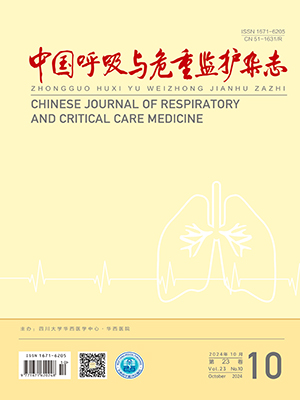| 1. |
俞森洋.机械通气中的几大争论和研究进展.中国呼吸与危重监护杂志, 2010, 9:341-343.
|
| 2. |
Gurevitch MJ, Gelmont D.Importance of trigger sensitivity to ventilator response delay in advanced chronic obstructive pulmonary disease with respiratory failure.Crit Care Med, 1989, 17:354-359.
|
| 3. |
Fabry B, Guttmann J, Eberhard L, et al.An analysis of desynchronization between the spontaneously breathing patient and ventilator during inspiratory pressure support.Chest, 1995, 107:1387-1394.
|
| 4. |
Lissens MA.Motor evoked potentials of the human diaphragm elicited through magnetic transcranial brain stimulation.J Neurol Sci, 1994, 124:204-207.
|
| 5. |
Sinderby C, Navalesi P, Beck J, et al.Neural control of mechanical ventilation in respiratory failure.Nat Med, 1999, 5:1433-1436.
|
| 6. |
Beck J, Campoccia F, Allo JC, et al.Improved synchrony and respiratory unloading by neurally adjusted ventilatory assist (NAVA) in lung-injured rabbits.Pediatr Res, 2007, 61:289-294.
|
| 7. |
Brander L, Sinderby C, Lecomte F, et al.Neurally adjusted ventilatory assist decreases ventilator-induced lung injury and non-pulmonary organ dysfunction in rabbits with acute lung injury.Intensive Care Med, 2009, 35:1979-1989.
|
| 8. |
Delisle S, Ouellet P, Bellemare P, et al.Sleep quality in mechanically ventilated patients:comparison between NAVA and PSV modes.Ann Intensive Care, 2011, 1:42.
|
| 9. |
Duyndam A, Bol BS, Kroon A, et al.Neurally adjusted ventilatory assist:assessing the comfort and feasibility of use in neonates and children.Nurs Crit Care, 2013, 18:86-92.
|
| 10. |
Barwing J, Ambold M, Linden N, et al.Evaluation of the catheter positioning for neurally adjusted ventilatory assist.Intensive Care Med, 2009, 35:1809-1814.
|
| 11. |
Chao DC, Scheinhorn DJ, Stearn-Hassenpflug M.Patient-ventilator trigger asynchrony in prolonged mechanical ventilation.Chest, 1997, 112:1592-1599.
|
| 12. |
Passath C, Takala J, Tuchscherer D, et al.Physiologic response to changing positive end-expiratory pressure during neurally adjusted ventilatory assist in sedated, critically ill adults.Chest, 2010, 138:578-587.
|
| 13. |
Colombo D, Cammarota G, Bergamaschi V, et al.Physiologic responseto varying levels of pressure support and neurally adjusted ventilatory assist in patients with acute respiratory failure.Intensive Care Med, 2008, 34:2010-2018.
|
| 14. |
佟欣, 臧彬.影响患者机械通气时间长短的危险因素分析.中国呼吸与危重监护杂志, 2012, 11:235-237.
|
| 15. |
郑大伟, 曾祥彬, 高峰, 等.呼吸系统功能评分指导机械通气治疗呼吸衰竭撤机的临床研究.中国呼吸与危重监护杂志, 2013, 12:146-149.
|
| 16. |
Schmidt M, Demoule A, Cracco C, et al.Neurally adjusted ventilatory assist increases respiratory variability and complexity in acute respiratory failure.Anesthesiology, 2010, 112:670-681.
|
| 17. |
Terzi N, Pelieu I, Guittet L, et al.Neurally adjusted ventilatory assist in patients recovering spontaneous breathing after acute respiratory distress syndrome:physiological evaluation.Crit Care Med, 2010, 38:1830-1837.
|
| 18. |
Beck J, Brander L, Slutsky AS, et al.Non-invasive neurally adjusted ventilatory assist in rabbits with acute lung injury.Intensive Care Med, 2008, 34:316-323.
|
| 19. |
Bertrand PM, Futier E, Coisel Y, et al.Neurally adjusted ventilatory assist vs pressure support ventilation for noninvasive ventilation during acute respiratory failure:a crossover physiologic study.Chest, 2013, 143:30-36.
|
| 20. |
Cammarota G, Olivieri C, Costa R, et al.Noninvasive ventilation through a helmet in postextubation hypoxemic patients:physiologic comparison between neurally adjusted ventilatory assist and pressure support ventilation.Intensive Care Med, 2011, 37:1943-1950.
|
| 21. |
Alander M, Peltoniemi O, Pokka T, et al.Comparison of pressure-, flow-, and NAVA-triggering in pediatric and neonatal ventilatory care.Pediatr Pulmonol, 2012, 47:76-83.
|
| 22. |
Ducharme-Crevier L, Du Pont-Thibodeau G, Emeriaud G.Interest of monitoring diaphragmatic electrical activity in the pediatric intensive care unit.Crit Care Res Pract, 2013, 2013:384210.
|
| 23. |
Blankman P, Hasan D, van Mourik MS, et al.Ventilation distribution measured with EIT at varying levels of pressure support and neurally adjusted ventilatory assist in patients with ALI.Intensive Care Med, 2013, 39:1057-1062.
|




